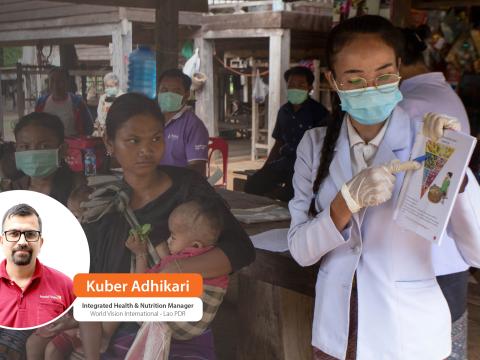Healthy Future for all is possible in Laos, but challenges need to be addressed to reach Universal Health Coverage

On the 12th of December, the world celebrated Universal Health Coverage (UHC) Day with the slogan “Build the world We want: A healthy future for all.” This day aims to advocate for universal health coverage for all. The World Health Organization (WHO) defines UHC as all people having access to the health services they need, when and where they need them, without financial hardship. It includes a full range of essential services, from health promotion to prevention, treatment, rehabilitation, and palliative care, meeting minimum service standards, made available for people from all backgrounds.
While modern health systems have a comprehensive range of services, around half of the world’s population doesn’t access health services when they need them. This situation is partly due to the uneven distribution of health services and financial inequalities. An estimated 100 million fall into extreme poverty because of out-of-pocket expenditures on health care. Health indicators such as maternal and child mortality and malnutrition are still alarming for many low-and-middle-income countries, with a massive disparity between the low-income and high-income countries on accessing and utilizing health services.
In Lao PDR, the Government of Lao PDR commits to achieving UHC by 2025. The National Health Insurance Scheme was introduced in 2016 to break the financial barriers and expand the coverage of health services to the hard-to-reach population. This encouraging initiative and a positive sign of change is unfortunately facing multiple challenges and complexities and has yet to be able to reach out to the marginalized population as much as expected. Despite the setup of different social protection schemes, out-of-pocket expenditure is still high in Laos, representing 41.83% of health expenses. Though the national UHC index has doubled from 2000 to 2017 (moving from 25 to 51), it is still halfway to achieving UHC and remains one of the lowest in East Asia.
During my last visit to one of the remote districts of Southern Laos, I could notice that Health Centers (the lowest level of health care service providers) are pretty far away from remote villages. Families mainly visit those Health Centers only when one of the household members is sick (curative services) and do not have regular access to preventive and promotive services like immunization of children, growth monitoring, or health education counseling. Immunization coverage is below 70%, and growth monitoring is irregular: this increases the risk of children being affected by malnutrition and diseases that are preventable with a vaccine. The integrated outreach clinic approach is one option to bridge the unequal access to health services in Laos: World Vision has been extensively working with 66 Health Centers to provide regular outreach clinic services in 171 remote villages in Luang Prabang, Khammouane, Savannakhet, and Saravane provinces. These mobile clinics come every quarter to provide health services directly in the village, effectively improving access to the mothers and children from hard-to-reach areas: children receive immunization, their growth is monitored, while mothers receive health education and ante-natal care (ANC). World Vision is also building the capacities of 137 health workers to properly execute their monitoring routines, training them on the Integrated Management of Acute Malnutrition (IMAM) and Integrated Management of Newborn and Childhood Illnesses (IMNCI).
On another level, a key to ensuring universal health coverage is strengthening the primary health care on each fundamental building block of the health system (WHO Framework), consisting of governance, legislation, finance, health commodities, human resources, and technology. Those are all interlinked and connected and require a strong commitment, coordination, and collaboration between the Government of Lao PDR and development partners, to have proper planning and budgeting for health, ensure transparency of the health information and accountability of all the stakeholders, guarantee appropriate resources with sufficiently equipped health workers in terms of quantity and quality, and sustainable management of health financing to leave no one behind and let the most vulnerable children and their families fulfill their rights to access quality healthcare.
About the author:
Kuber Adhikari is a seasoned development professional from Nepal, with more than 10 years of experience in planning, designing, and managing integrated health and nutrition, early childhood development, water, hygiene and sanitation (WASH), health system strengthening, humanitarian and disaster risk reduction programmes. He graduated a Master’s degree in Health and Sociology along with a Master’s in Philosophy-Demography and joined World Vision International in 2013, integrating Laos’ office in April 2022.